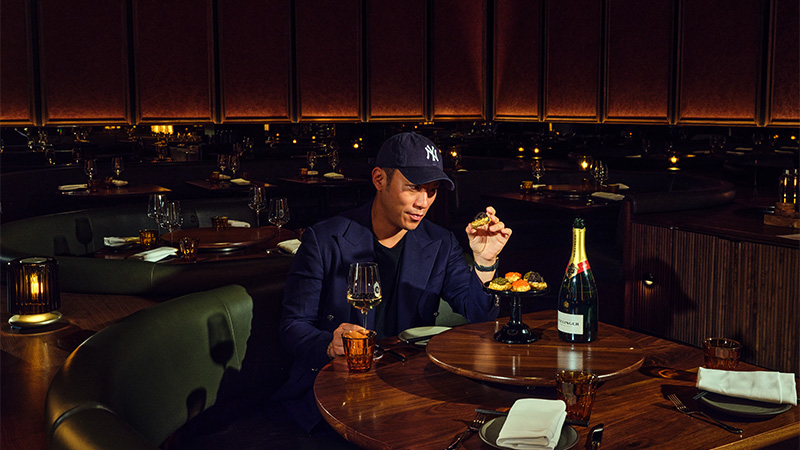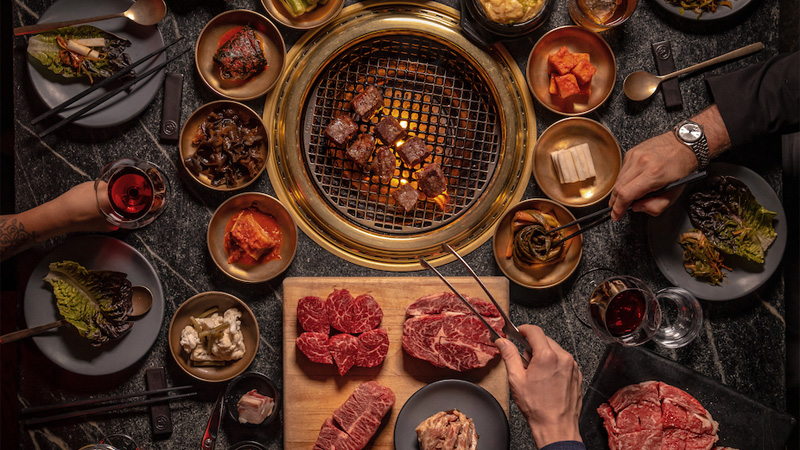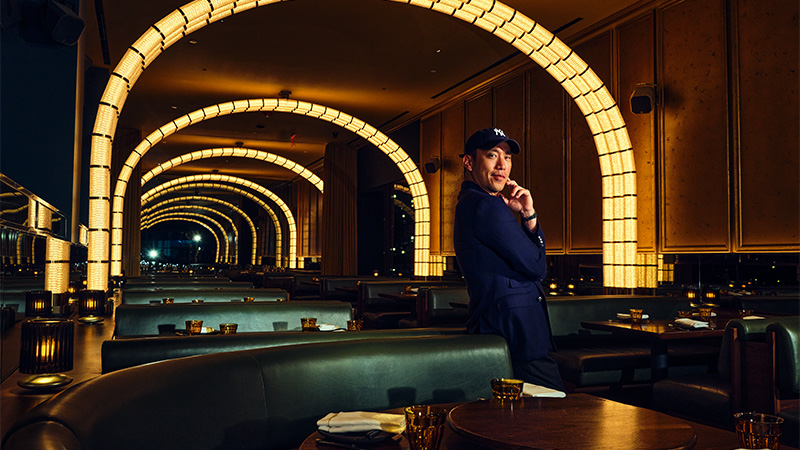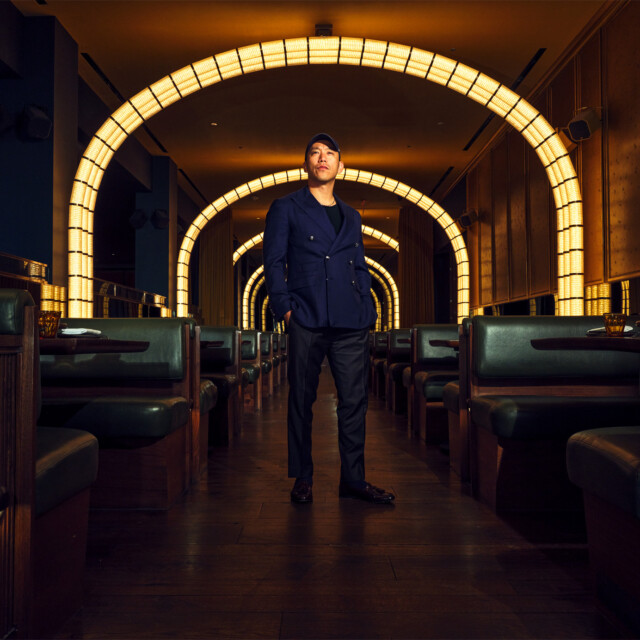When Simon Kim meets me at Coqodaq, his Korean fried chicken restaurant in Manhattan, he’s dressed for business and ready to let loose. He tucks into a curved banquette toward the back of the dining room and waves down a server. “Can we get three juice shots with vitamins and ginger?” he says, before turning my way with a conspiratorial grin. “Let’s chug these.”
Kim, 43, is a fine-dining maverick. After starting his career on the Las Vegas Strip, he landed in New York, managing fine-dining restaurants for chefs Jean-Georges Vongerichten and Thomas Keller. His restaurants, Coqodaq and the steakhouse Cote, are among the most influential names in dining right now.
His restaurants — there are four of them — are expensive but affordable, and flashy without the fuss. Two of his establishments have Michelin stars, and all of them have reservations available this week. In a crowded fine-dining scene, where paid memberships and hard-won tables are a draw, Kim is trying something else.
At Coqodaq, for instance, dinner starts at $42 per person for a reasonably sized set meal, called “the Bucket List.” It includes hot ginseng soup, cold perilla noodles, pickled banchan, a few pieces of fried chicken, and soft serve ice cream.
A meal can also cost several times that much. Besides the set meal, there are dozens of add-ons, ranging from a single chicken nugget with shaved truffle for $30 to a nearly $900 tin of Royal Beluga Hybrid caviar. The Champagne list has several hundred options.
“How much excess you want to have is up to you,” says Colin Camac, the strategic sales lead at Blackbird, a restaurant loyalty app. “Do I need the nuggets and caviar? No. Do I get the nuggets and caviar? Yes.”
The approach is different from most other restaurant groups, which treat high and low like oil and water: Parm is for lunch on Wednesdays; Carbone Privato is for card-carrying members. “People think it’s hard to house those extremes in one place,” Kim says. “It really isn’t.”
In a sense, that’s because of Kim. In his personal life, he drinks several Martinis or none at all, and may eat as many as three lunches in an afternoon. (That was the case when I met him.) On weekends, he attends functions with white tablecloth chefs and performs karaoke with Nas.

So far, it’s worked out. His restaurant company, Gracious Hospitality Management, has Cote restaurants in Singapore and Miami in addition to the New York flagship. And there is another one opening in Las Vegas this fall.
In 2026, he will unveil his biggest project yet — a three-restaurant buildout at 550 Madison Avenue in Manhattan. The deal includes another location of Cote and a sushi counter run by the chef Masahiro Yoshitake, the talent behind two Michelin-starred restaurants abroad.
“Some people will obviously spend a lot more money, which will help us serve a very value-driven food menu. If everybody came in and ordered the Bucket List and left, I don’t think I would be able to sustain my business.”
Kim is attempting to build the first Michelin-starred restaurant chain in America. And if you’ve ever spent an afternoon with him, you’ll know that’s all according to plan.
Not Only for the Elites
Kim was born in Seoul, South Korea, to parents who worked in restaurants and real estate. He was the unofficial “mayor” of his block, he says, and he was often late getting home because neighboring vendors would intercept him with fruits and candies on his walk.
When Kim was 13, his family immigrated to Long Island, N.Y., not far from a location of Peter Luger Steak House. “America’s best steakhouse at the time was on my front doorstep,” he says. Each year he saved his envelopes of money from Lunar New Year to visit.
Those early meals shaped his view of upscale dining. When he dined at Peter Luger as a teenager, he was struck by the people around him. “The clientele was very eclectic,” he says. The diners were firemen, mechanics, and cops. “It was an expensive night out, but it was not for only the elites and aristocrats.”

Kim started managing restaurants in his 20s. He was working in dining rooms on the Las Vegas Strip and became known as someone who could turn around a night of sales with a phone call. When business was slow, he dialed the hosts of neighboring casinos in search of big spenders.
“They could come in and drop $15,000,” he says. The secret to winning over that small subset of diners, he learned, was having a place for everyone. “Imagine a casino with only high-rollers or only penny slot machines. No one would want to be there.”
“The last thing I want to be is TGI Friday’s. There’s nothing more unsexy than a cookie-cutter American brand.”
He started to think of restaurants like “coral reefs,” he says. There were small fish and there were big fish. And, of course, there were “whales” — an industry term for the highest tier of spender: They paid the bills so ordinary people could order California rolls.
When Kim returned to New York and opened Cote in 2017, he based the business model on Las Vegas logic. The cost of dinner at the time, $45 for a set menu, was intentionally lower than most of his peers. The price was subsidized by sales of imported beef, rare vintage wines, and other add-ons.
The strategy is the same at Coqodaq. “Some people will obviously spend a lot more money, which will help us serve a very value-driven food menu,” Kim told me last year. “If everybody came in and ordered the Bucket List and left, I don’t think I would be able to sustain my business.”
Selling You a Dream
In America, Kim didn’t have to look far to find diners willing to splurge. And from the beginning, the idea was to have a Cote in every major city, says Amy Zhou, vice president of operations for Gracious Hospitality Management.
In the summer of 2018, Zhou met Kim while interviewing for a general manager position at Cote. The restaurant had been awarded a Michelin star a few months before, so she wore a suit. “He walked up in cargo shorts and Birkenstocks,” she says of Kim. “I’ll never forget that.”
Over several hours, Kim laid out his master plan. He wanted to open Cotes across the country, which was unheard of at the Michelin-starred level, and expand into chicken and seafood. Zhou thought she had signed up for a job interview. But no: “This man was selling you a dream,” she says.

Kim’s restaurants abide by a template, but no two are the same. The Cote in Singapore closes later than the Cote in Miami, which plays music louder than the Cote in Manhattan. And the menus reflect elements of their home cities. Diners on the Strip will be able to order truffle sandwiches, while New Yorkers have chicken over rice.
“The last thing I want to be is TGI Friday’s,” Kim says. “There’s nothing more unsexy than a cookie-cutter American brand.”
So far, it’s working. The Cote in Manhattan has retained its Michelin star since 2017 and the Miami location earned one in 2022. Besides Cote, only one other restaurant — Sushi Nakazawa — has been awarded stars at multiple U.S. locations.
Is it possible to build an empire of Michelin-starred restaurants? It’s too early to say, and at this point, Kim is taking life meal by meal. When I ask him about it when we meet at Coqodaq, he’s more interested in his third lunch. That day, it’s chicken nuggets with caviar.
